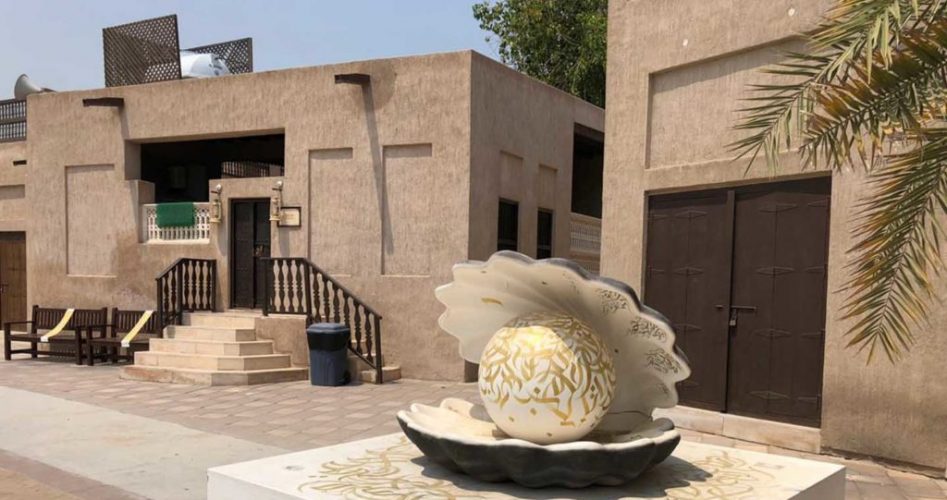A virtual tour at the Saruq Al Hadid Museum during the pandemic with the Anthropology students
Under the supervision of Faculty Dr. Leslie
Sarooq Al – Hadid
by – Elhusein Taha
Sarooq Al – Hadid museum is an archaeological site in southern Dubai. It was discovered in 2002 when his highness sheikh Mohamed was flying over in a helicopter and saw very strange black domes. After noticing the landscape his highness came back with experts and they dug to discover what was under the sand. What was discovered was artifacts from two different times which are the stone age, and the iron age.
The minerals used at the time where iron and copper it was the source of mineral, they mined from mountains and only twenty percent of the landscape has been discovered. The artifacts that have been discovered are swords, daggers, jewelry, war gear, axe head and arrow heads. The most interesting discovery found are the pots that are designed with snakes. Snakes where not known how to be dealt with in times of a snake poisoning a civilian, so they were praised because of that situation as antidotes did not exist and to this day pharmacy’s carry the logo with the shape of a snake. These artifacts are labeled with its year of finding and what it is made of and this information is usually gained after analyzing each artifact. The Greatest mystery about sarooq al – Hadid is the fact that the area showed so much signs of life before with the fossils of animals such as onyx, deer’s and many other animal fossils yet not a single human fossil was discovered but it was discovered the area was mainly for trading.
Knowing the history about the people who walked the earth before the people of today is a very important thing as anthropology teaches us every aspect of human existence. They show us difference of how life was lived by the day as in seeing the diverse ways of seeing the world and to also give us answers to our questions about ourselves and our past, present, future by connecting everyone from around the globe to their origins and cultural heritage. Some of the ways to raise awareness are heritage awards, heritage walk, and heritage trails which give a vast amount of knowledge and admiration to not leave what’s left behind as history and carry it forward as part of every individuals lives.
Introduction to Anthropology
by- Sara Issa
Saruq Al Hadid is an artifact museum located in Dubai and is considered one of the most important historical sites in the United Arab Emirates. The site was discovered by Sheikh Mohammed Bin Rashid Al Maktoum, the ruler of Dubai, when he was flying across the desert in his helicopter and noticed unusual formations in the sand dunes, as well as black dots scattered across the sand, which was found out to be “slag” – the waste of smelted metal ore. The showcase in the museum starts from the Stone Age (5,000 BC), continues through the Bronze Age (4,000 BC), and ends at the Iron Age (3,000 BC).
There are many different artifacts on display at the Saruq Al Hadid Museum, such as ceramics, arrowheads and axe heads, knives, fishhooks, jewellery (including a gold ring that the Dubai Expo 2020 logo was inspired by) and fish, camel and oryx bones. The artifact that intrigued me the most, however, was something fittingly named the “mystery object”. It was given this name due to the amount of time it took to figure out what it was even for. The object itself is made of metal and is said to have been used for both humans and camels, and for two reasons each. For humans, the first use/reason is it was used as weights for them to lift and build their strength, and the second one was to protect themselves. For camels, on the other hand, and these are the uses that I find more interesting, are to slow the camels down (they would be attached to a camel’s ankle), and also to be able to identify whose camel was whose. The latter reason is the one that I find most fascinating, because it’s almost like an ancient version of a collar that humans put on their pets which to me is funny to think about. It also really does further prove the fact that humans have always had this sense of ownership over things, which has been indicated in some of the first pieces of art thought to have ever existed and has continued to show throughout the different ages in time.
This can then of course be related back to anthropology, and is actually an important aspect of the subject, as since it is the study of humans and human societies, cultures, and their development (past and present), the many artifacts show said development, and allow us to understand how we as humans have not only stayed the same (just in more updated, modern ways), but also how we have grown, developed and evolved as a species – individually and collectively as societies. Also, the fact that the museum holds so many different artifacts of different types, it’s almost as if it gives us a ‘holistic view’ of the time periods that the artifacts represent, as we are able to see so many different branches or types of items that are all used for different things, so when we see them all together, we are given a wider view of what society and what people could have been like at the time and what they did.
The Saruq Al Hadid Museum does well to raise awareness and also to just inform people on the history of the UAE’s culture and society. One way they do this is via the artifacts on display. For example, they have items made from materials such as olivewood and pinewood, which indicate early relations/trade links with Levantine countries, as well as items made from metals not found in the Gulf, such as tin, and ceramics/pottery that are linked to Mesopotamia (modern-day Iraq). In fact, for this reason, all of these various artifacts are linked as factors behind Dubai’s present-day role as a global trading hub. The staff at the museum are also a huge influence on spreading the history and knowledge about the site, as well as the interactive experiences offered when visiting the museum, such as archaeological “digs” that visitors can take part in, which are all very important, as the people of the UAE have the right and should be able to learn and understand the history of their people and society.
ASC 102 – Introduction to Anthropology
by- Dunia Saadeh
Saruq Al Hadid is a museum that is located in Shindagha and was previously owned by SHK Jumaa Al Maktoum. Saruq Al Hadid is Arabic for ‘the way of iron’. The site was discovered after his highness SHK Mohammed bin Rashid was flying in a helicopter and found strange dunes. When specialists were brought, they found out that those were valuable artifacts. The eras that the museum own their artifacts from are the Stone and Iron Ages. Artifacts from the Stone Age include manufacturing tools, basic arrowheads, and other tools. The other stage shows the artifacts from the Iron Age as they have discovered that the site was a place of iron ‘factory’.
The black stones or dunes that were discovered were actually slags which are wastes from melting the iron. The museum found many tools, however, they focus more on weapons. They have showrooms of daggers and swords made from iron that have been found in Saruq Al Hadid. What is very interesting is that those weapons have animal shapes crafted in them. Specialists think that either those designs were inspired or the weapons came from India; as those animals didn’t live in the region. What reinforce the fact that Saruq Al Hadid was a factory is that they found more than 5,000 metal arrowheads. Moreover, they have found mysterious objects that look like not finished bracelets. Specialists believe they were put on camels’ legs to help identify their own camels from others. Now, what is more mind blowing is that archaeologists did not find any human bones or scripts, they only found the artifacts. So, they know nothing about the people that lived there, they only have their artifacts.
Saruq Al Hadid was also a focal or center point where people went there to work on the site, sell their goods, and then go back to their region. Potty were found that had Bahraini designs. Moreover, there are seals that were used as stamps. Many artifacts had snakes designed all around them. In that age people were afraid of snakes. So, they believed that if they draw it then it will protect them from snake poison. Moreover, jewellery like necklaces, earrings, and rings made up of gold were discovered. Actually the logo of EXPO 2020 was inspired by one of the gold jewellery pieces found. The reason is that the gold ring has 20 circles from inside and 20 rings from outside which represent the year of UAE hosting EXPO.
What I saw in the virtual tour reminded me a lot with what we studied in our course. We have studied about how archaeologists dig the ground to find artifacts. Also, how specialists in the laboratory can test and find out from which period or era the artifact belong to. The virtual visit have helped me see how important anthropology is. Through anthropology we have discovered and learned about the existence of the people and what they did before us in previous ages.
In conclusion, Souq Al Hadid is a museum that shows a very mysterious and thrilling site that was discovered. It contains many artifacts that mostly belonged to the Iron Age. The site is believed to be a ‘factory’ of iron. Furthermore, Souq Al Hadid aids in raising awareness about the history and culture that existed in UAE. It preserves the history of UAE and portrays the stories and show the lives of communities that lived before us. It educate the modern society how previous societies lived, clothed, and tools they used.








